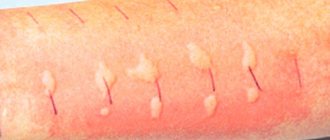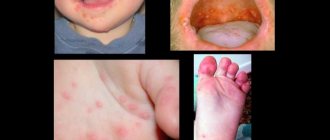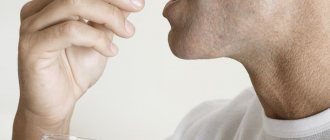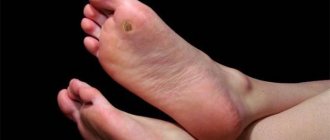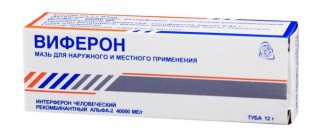Itching of the pubis is very unpleasant and causes a lot of inconvenience.
After all, it is indecent to scratch your pubic area in a public place.
Often such itching indicates the appearance of some kind of disease.
We will look at what diseases cause pubic itching in this article.
The presence of lice pubis, herpes, all kinds of parasites, allergic reactions and the like are the main reasons.
The pubic area will itch and itch after shaving or as a result of sexually transmitted diseases.
Often itches due to the presence of candidiasis or thrush.
Fungi are found in the groin area and genitals.
Symptoms of thrush:
- The presence of severe itching of the pubic area, in men also of the scrotum
- underwear covered with a whitish, cheesy coating
- Often, urine output is painful
- uncomfortable sex with a feeling of intense itching
It is imperative to be treated by a qualified specialist, without self-medication.
The doctor will evaluate the pros and cons, make a diagnosis and prescribe adequate treatment.
Often thrush provokes the appearance of purulent pimples on the pubic area.
Decreased immunity contributes to this.
Pimples flake and itch very much.
You also need to be treated by a specialist.
He will help determine the concomitant pathology and prescribe the correct treatment.
Also, if your pubis itches, it’s because of genital herpes.
It's an STD.
The pubic area becomes covered with small watery blisters, which cause itching and burning of the pubis.
These pimples later burst and ulcerate.
They need to be treated, but healing is slow.
The genitals are affected by herpes if the infected person has herpes on the oral mucosa.
The causes of relapse are emotional and temperature stress on the skin; pregnancy and exacerbation of chronic diseases.
Another cause of itchy sensations on the pubis can be an allergy to components of underwear, products and personal hygiene items in women.
These irritants should be excluded and products with an antihistamine effect should be used.
Pediculosis pubis is characterized by itching of the pubis.
Women still have itchy labia.
The presence of lice in the pubic hair is the cause of the disease.
The pubis becomes covered with small cracks and is very itchy.
There are different reasons for itching of the pubic area:
- disturbances in the gastrointestinal tract
- chronic presence of stressful situations
- presence of dysbacteriosis, diabetes mellitus or leukemia
- problems with hormonal levels
- the presence of stripe-like skin atrophy or pink zhibert
- presence of molluscum contagiosum or cancer
Intimate hygiene requires constant adherence.
If this is not the case, scratches may appear on the pubic skin, which can become infected.
Why does pubis itch in men?
Failure to comply with the rules of personal hygiene is the main reason why the pubis and groin area itch in men.
Other root causes are considered to be the presence of:
- genital herpes
- chlamydia
- ureaplasmosis
- lice pubis (phthiriasis)
- scabies
- inguinal dermatomycosis (athlete's foot)
- various skin allergic reactions
In addition, the cause may be various diseases of the liver (such as viral hepatitis) or pancreas; mental problems; some blood diseases; HIV infection.
Some kidney diseases increase the concentration of nitrogen in the blood.
This nitrogen irritates skin receptors when present in sweat from the sweat glands.
There are such sweat glands on the pubis, and itching occurs there too.
Treatment is specific and depends on the cause of the pathology.
It must be determined by a doctor.
During treatment, you need to avoid sexual contact, say goodbye to bad habits and switch to a diet.
This comprehensive approach to treatment makes it effective and the itching in the groin stops.
If everything is done correctly, then relapses can be avoided and the itching will stop in 7-10 days.
The intensity of itching will help reduce the use of some folk remedies.
Here are some as an example:
- Make an infusion of three tablespoons of a mixture of equal amounts of dry oregano, sage, chamomile flowers and oak bark. Pour boiling water (0.6 liters) into this mixture for 24 hours. Using the strained infusion, apply lotions to the pubis for about 30 minutes.
- Using a series, or rather a decoction of it (one hundred grams of dry herb per liter of water, boil for 15 minutes), baths are made (adding the decoction to the water).
- Lotions based on nettle decoction (two tablespoons of dry raw material per two glasses of water and boil for ten minutes).
- Previously chopped elecampane roots (two tablespoons) are poured with a glass of water and boiled for twenty minutes, then mixed with fresh lard (one tablespoon). The ointment is applied to the pubis daily.
- Peppermint is used to prepare an alcohol tincture. 1 tbsp. a spoonful of dry mint is poured with ethyl alcohol, moonshine or vodka. You need to infuse for about two weeks and lubricate the itchy areas with the strained tincture.
- Applying compresses made from a decoction of burdock roots to the affected area is also effective. Crushed roots, one hundred and fifty grams, are poured with five hundred milliliters of water. All this boils for thirty minutes.
For any diagnosis, daily personal hygiene of the genital and pubic area is mandatory.
Genital herpes is treated with antiviral drugs - acyclovir, foscarnet, famciclovir.
When treating chlamydia, the immune response is increased - taquitin, lysozyme, methyluracil and decaris.
To restore the intestinal microflora, they use mezim, festal and panzinorm.
Local treatment is also used.
Antibacterial drugs are prescribed for the treatment of ureaplasmosis.
Treated with ornidazole, spiramycin, doxycycline.
Physiotherapy is also widely used.
Pediculosis pubis is treated with antiparasitic ointments.
You can prevent relapses of the disease by taking certain actions:
- regular washing and ironing of bed linen and clothes
- shaving your pubic area before treatment
- strictly follow the instructions for applying antiparasitic ointment
- immediate antiseptic treatment of carpets, upholstered furniture and other items of daily use for men (due to the high survivability of the pediculosis pathogen)
Scabies mites are treated with lindane and crotamiton.
Traditional methods of dealing with ticks are ineffective.
Antihistamines, antimycotic ointments and special lotions are effective for the treatment of inguinal dermatomycosis.
How is the diagnosis done?
Itching or burning in the groin is not a specific symptom and cannot indicate any specific disease.
In this regard, the doctor must collect a detailed medical history and prescribe numerous laboratory tests for the patient.
After consultation with a urologist, if it becomes clear that the cause of the itching in the groin is a venereal disease, the patient’s allergic reaction will be redirected to specialized doctors who will prescribe the correct medicine.
To identify the cause of itching in the groin, the following series of diagnostic measures are carried out:
- The first of them is an anamnesis during which the doctor clarifies: What the patient is complaining about, how long it has bothered him;
- Asks about the patient’s lifestyle;
- What other diseases does he suffer from?
- Find out if other family members have similar symptoms;
- The patient is interested in whether the patient had unprotected sexual intercourse.
- The doctor examines the genitals and their condition;
- If HIV, hepatitis, or syphilis is suspected, a blood test is taken;
Why does pubis itch in women?
In women, the pubis most often itches due to irritation after cosmetic procedures (hair removal, depilation, intimate hairstyle).
In addition, lovers of various extreme sex often itch.
There are women with sensitive skin.
Their pubis itches from all kinds of chemical irritants (intimate hygiene products), and, in particular, from chlorinated water, for example in a swimming pool.
These problems can be solved with the help of special soothing creams, gels and showers made from non-chlorinated water.
Sometimes menstruation can cause pubic itching.
You need to consult a gynecologist to determine the cause and solve the problem.
The causes of pubic itching in men are also common in women.
This includes violations of hygiene rules.
We need to remember this, especially since violation of intimate hygiene for women, due to the anatomical features of the female body, is more dangerous.
All diseases that cause pubic itching in men also cause it in women.
If the reasons for the itching are not medical, then the main thing to combat itching is to follow the rules of hygiene.
If shaving and depilation cause itching and irritation of the skin, then for treatment you need to use creams that relieve skin irritation.
To relieve skin irritation, use miramistin or chlorhexidine.
If you are intolerant to hard water, soften it with vinegar or lemon juice.
But it is better to use special intimate hygiene products to maintain the balance of the internal environment of the genitals.
Thrush must be treated with specific therapy and a special diet (to improve the effectiveness of treatment).
Otherwise, relapses will occur, and the medication will need to be resumed.
This is very important if vaginal discharge is very profuse.
When may irritation appear in the intimate area?
The cause of irritation in the intimate area can be a variety of circumstances. Even habitual actions that at first glance do not carry any risk can lead to a feeling of discomfort. The most common cases when a woman may experience irritation in the most delicate area:
- after shaving
. Removing unwanted hair with a razor often leads to microtrauma. Such wounds become entry points for pathogens, and irritation develops as a result of infection. A machine with dull blades is especially dangerous in this regard. In this case, the likelihood of cuts and infection increases significantly. Another risk factor related to shaving is using the wrong product to help remove unwanted hair (such as soap or shower gel); - after intimacy.
In some cases, intimate intimacy itself becomes a cause of irritation due to injury to the mucous membrane of this delicate area. But most often, irritation develops when there is insufficient lubrication and dryness of the mucous membrane, when using lubricants with flavors, or if contraception is used (suppositories, vaginal tablets, condoms with flavored lubricant, etc.), to which a woman has increased individual sensitivity or is allergic; - after taking antibiotics
. In many cases it is impossible to do without antibiotic therapy. But these drugs cannot distinguish between harmful and beneficial bacteria and strike both the former and the latter with equal force. However, the microflora of the intimate zone, which consists of many types of beneficial bacteria, plays a very important role for women's health. When their number decreases, other microorganisms begin to predominate in the microflora, in particular Candida fungi, which can cause inflammation and severe discomfort in the intimate area.
Pregnancy and pubic itching
Itching of the pubis occurs quite often in pregnant women.
The main reason for this is hormonal imbalance.
All this leads to a decrease in the immune response, an imbalance of the vaginal microflora and provokes the proliferation of opportunistic and pathogenic vaginal microflora.
Reasons why pubic itching occurs in pregnant women:
- the influence of external factors on the genitals
- pathological changes in the genitals
- pathological changes in internal organs
- psychosomatic problems
The influence of external factors includes:
- all kinds of infectious agents
- failure to properly care for the intimate area (irregular showering and changing sanitary pads)
- mechanical irritation (causes: rough synthetic underwear, unnecessary vaginal douching, use of scented hygiene items)
- presence of strong and prolonged exposure to low or high temperatures
Pathologies of the genitals that provoke itching of the pubis include;
- the presence of pathological discharge from the vagina (with inflammation in the uterus)
- genitourinary fistulas, leading to constant leakage of urine and inflammatory irritation of the genitals and pubis
Presence of diseases of internal organs:
- diabetes mellitus
- chronic diseases of the urinary and urinary organs
- anemia
- lesions of the liver tissue and thyroid gland
Psychological problems are:
- the presence of prolonged stress and depression
- presence of fear of planned labor
In pregnant women, the most common causes of pubic itching are infectious diseases.
They suffer from thrush, gardnerellosis, genital herpes, trichomoniasis or chlamydia.
Pediculosis and pubic itching
Pediculosis pubis or phthiriasis affects the genitals and pubis of a person when pubic lice settle there.
For this zone, the presence of apocrine glands is important, the smell of which attracts lice.
Lice feed only on blood from the human body on which they live.
If there is no blood for a day, the pubic louse dies.
But in a state of suspended animation it survives for several months.
If there are no symptoms of the disease yet, then this is the incubation period - about thirty days.
Pediculosis can only be contracted from humans.
It is impossible to get infected from animals, since lice do not live on the body of animals.
The most important symptom of lice pubis is itching of the skin, primarily on the pubis.
That is, where lice enter the human body.
The patient reacts to itching and scratches the pubic skin.
Hyperemia and eczematous rashes occur, and a secondary infection occurs.
In addition to itching of the pubic area, a symptom of lice pubis is the presence of short-lived blue or shadow spots of a centimeter in diameter on the skin of the pubis.
They appear from hemorrhages when lice “work” on the pubic skin.
The abdomen, chest, lateral surfaces of the torso and thighs are the favorite locations of spots.
The spots are clearly visible, since the hair in these places is weakly expressed.
Occasionally, an allergic reaction in the form of a rash occurs to lice.
If pubic lice or parasite larvae are found on the skin or underwear, then this is clear evidence of pediculosis.
Pediculosis pubis itself is not dangerous.
Trouble comes from lice secretions, which cause allergic irritation on the skin and general allergic reactions.
A much greater danger is brought by the presence of scratches and scratches on the skin, through which the body becomes infected with various STDs.
The main causes of itching
There can be many reasons for the appearance of itching in the groin in men, from the most banal, such as violation of hygiene rules, to serious infectious diseases, the consequences of which are often dangerous for the body.
Here are the most common of them:
| Poor personal hygiene | Very often the cause of itching is poor adherence to simple rules for caring for the intimate area.
|
| Allergic reactions | Also, itching in the groin in a healthy man can be caused by allergies. A small rash that is also very itchy and red spots in the groin area may indicate an allergic reaction to various external irritants. Among which the most common are:
|
| Candidiasis
| The cause of burning and itching in the genital area in men may be the development of candidiasis; there is a risk of contracting it during sexual intercourse. In representatives of the stronger sex, this fungal infection is extremely rare. But if a man has a weakened immune system, then there is a possibility of active reproduction of these microorganisms. In addition, diabetes mellitus can also cause the development of thrush. Characteristic signs of this disease:
The possibility of sexual intercourse is excluded. |
| Inguinal ringworm | This is another fungal disease. It often spreads among athletes and men whose lives involve physical activity, often accompanied by profuse sweating. The groin, which has a moist and warm environment, is an ideal place for it. Infection usually occurs through contact with other people's things or animals that remain infected or in public places. Inguinal ringworm primarily affects the scrotum area, then spreads to the groin, abdomen and thighs. Symptoms of this disease include:
|
| Genital herpes
| Mainly transmitted sexually. A household route of infection is also possible. When it enters a healthy and strong body, the virus does not multiply, but waits for it to weaken. The incubation period is approximately a week. Then the first symptoms appear:
Afterwards, rashes form in the groin area in the form of transparent blisters, which in men are most painful on the head of the penis. These rashes also occur on the inner thighs and buttocks. The blisters burst when touched, causing ulcers and pain. This disease is not fatal at all and does not even disrupt the functioning of organs, but it causes enormous discomfort. |
| Chlamydia | Among all sexually transmitted diseases, chlamydia ranks first in frequency. Moreover, it is one of the most dangerous, due to the fact that in 46% of men it is asymptomatic. Damage to not only the genitourinary system, but also the respiratory, cardiovascular, musculoskeletal, and visual organs is possible. Ignoring treatment for chlamydia is very dangerous. Symptoms of chlamydia may include:
|
| Ureaplasmosis | A pathological disease that is sexually transmitted, caused by microorganisms called ureaplasma. They live in the urinary tract and on the mucous membranes of the genital organs and can cause a large number of different ailments. Household infection is unlikely. Most often, while in the body, ureaplasma does not cause infection, but if it develops, the following symptoms appear:
For the most part, ureaplasmosis is dangerous because it can lead to infertility. Another consequence of this disease is inflammation of the urethra (urethritis) and the formation of kidney stones. |
| Pediculosis pubis | A parasitic disease called pediculosis pubis (phthiriasis) is caused by flatheads. They are also called pubic lice. These parasites are small in size (1-3 mm), they can be seen with the naked eye, but due to the fact that they are inactive, they are not always easy to detect. They prefer hairy areas of the body (pubis, genitals, areas around the anus), and less often others. They feed on the host's blood. You can become infected with phthiriasis through:
The incubation period lasts about a month. Symptoms of lice pubis:
Lice themselves are not dangerous to humans, but scratching the skin weakens their protective function, which can lead to infection with other diseases. Lice secretions can cause an allergic reaction in the patient. |
| Scabies | Pruritic dermatosis or scabies is a skin infectious disease. It is caused by a subcutaneous mite called itch. You can catch it both in everyday life (shaking hands, using contaminated clothing) and through sexual contact. Unsanitary conditions and the presence of diabetes can contribute to infection. Symptoms of scabies usually appear one month after infection. The most obvious of them:
In addition to discomfort, scabies can lead to purulent skin lesions - pyoderma, eczema and urticaria may occur. |
| Diabetes | It is more common in obese people and is a non-transmissible disease. The causes of this disease are usually previous viral diseases, immune system disorders or hereditary predisposition. Symptoms of diabetes in addition to itching in the perineal area are:
Wound healing slows down significantly. This is a very dangerous disease, if you suspect it, you should immediately consult a doctor. The consequences may be different:
|
| General diseases | In addition to diseases affecting the groin area of a man, various general diseases of the body cause itching. Various diseases of the liver and kidneys, as a result of which the saturation of nitrogenous compounds in the blood increases, such as creatine, often lead to unpleasant sensations in the groin. Itching in the groin may also indicate:
In the anogenital area, itching is evidence of stool disorders, chronic constipation, hemorrhoids, and disturbances of intestinal microbiocenosis. |
HIV infection and pubic itching
HIV infection causes a general decrease in the immune response in the body.
An itchy rash, including on the pubic area, is caused by HIV infection:
- viruses
- vascular pathologies
- mycotic lesions
- papular rash
Itching with HIV infection is often caused by herpes.
Frequent exacerbations cause difficult-to-heal ulcers.
If there is HIV infection in the body, any disruptions lead to the appearance of itchy skin rashes, including on the pubis.
Skin damage leads to pyoderma and acne.
Fungal infections of the skin, which are more common in men, can also cause itching, including in the groin and pubic area.
Candidiasis is characterized by rapid development and a large affected area.
Treatment of skin problems due to HIV infection is quite complex.
It is carried out by specialists dealing with these problems.
Antiretroviral drugs are selected individually.
The presence of other pathologies and the general status of the person must be taken into account.
Various combinations of Virisept, Timazid, Videx are used.
To curb the replication of HIV, special inhibitors are used.
In general, we must always remember that successful therapy for HIV infection lies in restoring or at least stabilizing the immune response.
How to treat chafing in an intimate place
If children's ointments are excellent for treating groin irritation in men, then why not use other treatment methods, for example, traditional medicine, especially since the nature of the irritation is the same in both children and adults? For these purposes, medicinal herbs are used, which you can collect yourself or purchase inexpensively at a pharmacy, vegetable oils, and homemade ointments. At the same time, do not forget to see a doctor.
You just have to understand that serious diaper rash in the groin area cannot be cured with folk procedures alone. However, they are ideal for complex treatment of minor skin problems in the groin area. Here are some traditional medicine recipes:
- Herbal decoction baths . It is best to use chamomile, calendula, and string here. These herbs have an antiseptic and healing effect, reduce swelling and relieve inflammation. It is recommended to use oak bark. This product has a unique property - upon contact with the skin, it reduces sweating, which often becomes the culprit of the problem. To prepare the decoction, you need to pour three tablespoons of the herb with one liter of boiling water and let it brew for half an hour. After this, the finished broth must be filtered, and then diluted one to five with warm water. The bath is ready.
- Lotions from medicinal herbs . The decoction is prepared from the same herbs in a similar way. Cotton pads or a piece of clean cotton cloth are soaked in it and applied to the sore spot. Keep for 15 minutes. After the procedure, the groin should be wiped dry and lubricated with ointment.
- Sterile vegetable oil . Diaper rash in young children is often treated with regular sterile vegetable oil. For these purposes, sunflower, olive, coconut or their solution with the addition of two drops of lavender essential oil is perfect. Pour some oil into a glass bottle and place it in a water bath to sterilize. The finished medicine is stored on the refrigerator shelf and used as an ointment.
Streptoderma and itching on the pubis
A person is affected by streptoderma if the skin becomes infected with streptococcus.
The incubation period is seven to ten days.
Infection occurs through contact and household methods.
Kidney failure and diabetes mellitus lead to chronic streptoderma.
Also, the transition from the acute course of the disease to the chronic form is facilitated by a deterioration in the immune response, trauma to the skin, and diseased veins leading to varicose veins.
The symptoms of streptoderma are as follows:
- the presence of pink rashes on the skin, including on the pubis, with slight itching
- the surface of the rash is covered with dry crusts, which dry out and peel off
- regional lymph nodes enlarge and the temperature slightly increases
They are treated with Amoxiclav, Flemoxin-solutab, Azithromycin, Dimexide and Ichthyol ointment.
They are also treated with antihistamines.
Treatment of the disease is controlled by a dermatologist.
To prevent streptoderma on the pubis, you must strictly adhere to the rules of intimate hygiene, wash your hands thoroughly before eating and after being in a public place.
What allergic reactions cause the pubis to itch?
Pathological conditions of an allergic nature, which are characterized by damage to the skin of the pubis and genitals, are called genital allergies.
Symptoms depend on the form of the disease.
Genital allergies are manifested by redness, swelling, itching, burning and dry skin at the site of the lesion.
Certain allergenic substances provoke a specific immune response.
The mechanism of allergens entering the human body is local or systemic.
The local mechanism is when the allergen comes into direct contact with the skin, in our case the pubis.
The systemic mechanism involves penetration of the allergen parenterally, through the gastrointestinal tract or lungs.
A cascade of pathogenetic transformations potentiates local changes in the pubic skin.
Allergic nature is noted in:
- contraception
- male sperm
- all kinds of medications
- cosmetics and hygiene products
- underwear
An allergic reaction is always characterized by redness of the skin and itching.
Occasionally swelling of the pubis.
Treatment of skin irritation in the groin
Treating groin irritation in men should be taken seriously. First, you should rule out an allergic reaction to clothing or detergents and undergo an examination by a venereologist. The easiest way to relieve groin skin from redness and itching is ointment. If you have any doubts about the choice of a particular drug, it is best to consult a dermatologist: he will write a prescription for a suitable remedy for the treatment of skin irritation.
Ointment
The following ointments are popular for the treatment of diaper rash and irritation in the groin area in men:
- Zinc ointment . It dries and relieves redness and itching in a man's groin. It should be applied to clean, dry skin several times a day with light massage movements. It is advisable to avoid underwear for 10 minutes after applying the ointment to the skin. If there are household members nearby, you can wear a robe.
- Desitin cream . A special feature of this drug is the creation of a protective film consisting of zinc oxide, cod liver oil, lanolin and petroleum jelly. All these substances promote healing, dry out pimples, and remove inflammation. In addition, they prevent sweat and urine from corroding the skin for a long time, which is especially important for men who do not have access to a shower all day.
- Drapolene . The active ingredients of this ointment are cetrimide and benzalkonium chloride, which work as antiseptics. Lanolin and glycerin soften and soothe inflamed skin. Drapolene has a specific smell that many children do not like, but this should not stop an adult man.
- Lamisil . The groin area is a favorite place for fungi, and this antifungal drug is traditionally good.
- Bepanthol . This light cream perfectly helps with local diaper rash, saves from prickly heat, abrasions and other chafing. The composition contains vitamin B5, which promotes rapid skin regeneration. This means that wounds and rashes will dry out instantly. The disadvantage is that it comes in a tin tube, which means that the product is used uneconomically. Apply only to dry skin.
- Pantestin . Has the form of a gel. Used to prevent infectious diseases. Panthenol and miramistin are the active components of Pantestin and act as antiseptics, reducing inflammation. Not suitable for dry skin due to alcohol content.
All these remedies act very gently; they are also used to treat groin rash in children. If the irritation on the skin has become dangerous or more than a month has passed and the ointment cannot cope with it, then it’s time to visit a dermatologist. The doctor will do tests, diagnose the disease, and prescribe the necessary medications, including antibiotics. Such serious treatment is sometimes simply necessary, since severe irritation often results in bacterial infection of the skin.
- Dietary soups - recipes with photos. How to cook light vegetable or chicken dishes for diet and weight loss
- First aid for cardiac arrest
- Mustard for hair: masks for growth and hair loss
Treatment of itching on the pubis
Self-medication is effective only if there are no serious illnesses.
Therefore, it is imperative to visit a specialist and rule out serious pathology.
Home treatment is for local pubic irritation and local rash only.
Use the following means:
- iodine grid
- aloe leaves
- Vishnevsky ointment
- left-handed
- hydrogen peroxide
The effect of iodine is to disinfect the pubic area and dry the skin.
This prevents secondary infection and the occurrence of pyoderma.
An aloe leaf is cut in half and applied to the pubic area with an itchy feeling.
Fixed with adhesive tape.
Such actions are most effective in the evening, before going to bed.
This treatment consists of three sessions.
Vishnevsky ointment and levomekol are also treated by application to the affected areas of the pubis.
It is necessary to rub in the ointments until the itching stops and the hyperemia disappears.
Twice a day, in the morning and evening, the pubis is treated with 3% hydrogen peroxide until improvement occurs.
Whichever remedy is most effective should be used.
Let's take a closer look at the treatment of thrush (candidiasis).
This is a very insidious and protracted disease.
It is always accompanied by itching of the genitals and pubis.
You can relieve the itchy symptoms of thrush at home.
But to successfully determine the cause of the disease and effectively cure candidiasis, you need to consult a specialist.
Rules of conduct for people with thrush:
- during treatment, complete abstinence from sexual intercourse
- strict adherence to intimate hygiene (wash twice a day, without soap and with low water pressure)
- do not use panty liners, and during the month, replace intimate hygiene products no later than after four hours and always wash after this procedure
- use only natural cotton underwear
- exclude alcohol, tobacco products, and taking medications containing hormones, as they aggravate thrush
- use only medications (ointments, creams, suppositories, etc.) prescribed by the doctor
They are treated with ointments and creams containing clotrimazole, tioconazole or butaconazole.
Applications are made to the vagina and external genitalia.
The drugs are applied in small portions, repeatedly, throughout the day.
Treatment of groin itching
Treatment of the disease begins with eliminating the cause that caused the itching in the groin. Treatment for this symptom depends on various points.
If personal hygiene is not observed
Failure to comply with basic rules of personal hygiene is the most common reason that causes itching in a man’s groin.
In this case, you must:
- Shower more often - at least twice a day;
- Folk remedies, such as lotions made from decoctions of calendula, chamomile, oak bark, sage, and celandine, also promote rapid recovery;
- To eliminate dryness and soften the skin in the groin area, vegetable oils, previously sterilized by steam (30 min), help;
- The use of hormonal ointments such as Sinaflan or its analogs (Prednitop, Alergoderm, etc.).
Sinaflan
Prednitop Alergoderm
For an allergic reaction
In this case, you need to immediately identify the allergen.
If a man experiences itching in the groin due to exposure to an allergen, the following is recommended:
- Make sure that diet is not the cause, eliminate foods that cause this reaction;
- If the reason is synthetic underwear, you need to give it up;
- Baby powder applied to the groin area will also help;
- The use of anti-allergy medications (antihistamines) prescribed by a doctor, such as Diazolin, Suprastin;
- Furacilin;
- Careful genital hygiene is highly recommended.
Diazolin
Suprastin Furacilin
For candidiasis
When this disease occurs, complex treatment is used, consisting of diet, traditional methods and medication:
- As in most cases, it is important to keep the groin area clean;
- A diet that restores microflora, which includes vegetables, dairy products, and avoidance of flour products;
- Vitamin preparations aimed at strengthening the immune system;
- Nystatin, Fluconazole, Pimafucin, Clotrimazole and other antimycotic drugs;
- As well as products aimed at restoring the microflora of the genital tract and intestines.
Nystatin
Fluconazole Pimafucin Clotrimazole
For dermatomycosis
It is important to maintain hygiene during treatment of inguinal ringworm and after it. You should wash the affected area with tar soap or baby soap. It is important to take care of changing underwear to non-tight ones and eliminating synthetics. It must be washed at high temperatures.
Dermatomycosis of the groin is treated with the following methods:
- Creams and ointments, such as Ketoconazole, Econazole, Clotrimazole and others;
- Lotions made from furacilin, chlorhexidine, and potassium permanganate will help;
- A compress of castor oil, birch tar and egg white, applied at night. This compress is not recommended to be used more than two to five times;
- Decoctions of chamomile, string, celandine, and sage will help in the fight against inguinal ringworm;
Ketoconazole Econazole Clotrimazole
For herpes
Treatment of genital herpes is a complex and long process, which includes a general increase in the body's defenses and the use of general antiviral drugs:
- Acyclovir;
- Famciclovir;
- Foscarnet;
- Amiksin;
- Poludan.
Acyclovir
Famciclovir Foscarnet
Amiksin Poludan
For chlamydia
This sexually transmitted disease is treated mainly with antibiotics, which greatly weaken a man’s immunity, as well as his microflora.
The following drugs are used for treatment:
- Azithromycin;
- Clarithromycin;
- Rulid;
- Macropen.
Azithromycin
Clarithromycin
Rulid
Macropen
To help an organism weakened by these antibiotics, immunity-stimulating agents Taktivin, Lysozyme, and Dekaris are prescribed. And to protect the intestinal microflora Panzinorm, Mezim and others.
For ureaplasmosis
To treat infection caused by ureaplasma, potent antibacterial drugs are used that can destroy the infection:
- Spiramycin;
- Josamycin (Vilprafen);
- Doxycycline;
- Ornidazole.
Spiramycin
Vilprafen (Josamycin)
Doxycycline
Ornidazole
Treatment sometimes lasts more than one month, especially with an advanced form. Immunomodulators such as Wobenzym will help the body fight this disease. Maintaining groin hygiene will also not be superfluous.
For pediculosis pubis
It is impossible to get rid of pubic lice by simple washing; you will need to use special products, and perhaps in advanced cases, when there are a lot of parasites, you will have to shave off the hair in the groin and anus area.
Both partners must undergo the treatment procedure. In addition, it will not be possible to get rid of parasites without heat treatment of the laundry.
List of remedies that will help in treatment:
- Aerosol Spray-Pax;
- Nittifor;
- Medifox;
- Shampoo Veda;
- Soap Vitar;
- Malathion.
Spray-Pax
Nittifor
Medifox
Shampoo Veda Soap Vitar
Malathion
For scabies
The scabies mite that lives in the groin area causes great inconvenience.
To eliminate it, the following antiparasitic drugs are used:
- Permethrin is an ointment, two applications of which may be sufficient;
- Spregal is an aerosol that contains neurotoxins that are dangerous for ticks, so it should not be inhaled;
- Crotamiton;
- Lindane is an emulsion that is rubbed into the skin. A three-day course of treatment is usually sufficient.
Permethrin
Spregal
Crotamiton
Lindane
After completion of treatment, it is necessary to carry out the treatment at home. Things that cannot be boiled in a solution of washing powder should be hung out in fresh air for a week, the rest should be processed. Wash floors with water and bleach or soda. Treat upholstered furniture with steam using a hot iron.
With erythrasma
Treatment of erythrasma will be ineffective if due attention is not paid to disinfecting the patient’s belongings and maintaining hygiene. The patient needs to shower twice a day. Mandatory use of anti-inflammatory and antibacterial liquid soap.
Drugs prescribed for erythrasma:
- Erythromycin ointment;
- Salicylic alcohol;
- Glycerin-salicylic alcohol;
- Mycosporus;
- Clotrimazole;
- Sodium thiosulfate solution;
- Sulfur-tar ointment.
Erythromycin
Salicylic alcohol
Mycospor Clotrimazole
Sodium thiosulfate
Sulfur-tar ointment
Folk remedies
Folk remedies such as decoctions of oak bark, immortelle, sage, and chamomile will help in treatment. A tincture of birch buds in alcohol is also used. Ultraviolet rays have a disinfecting and antiseptic effect, so tanning should not be neglected.
Preventing pubic itching
Preventive measures involve following certain rules.
- Strict and regular adherence to intimate hygiene. It's even better to overdo it than to underdo it. A little too much cleanliness won't hurt.
- Before taking medications, carefully read the section of the instructions related to side effects. If this is possible, then it is necessary to take antihistamines.
- Do not overcool, always insulate the legs and organs of the MPS and keep them in dry, clean clothes and shoes. This is the prevention of any inflammatory diseases.
- For sexual contacts, a permanent sexual partner is required.
If the genitourinary, endocrine and digestive systems are not in order, this can lead to rashes on the pubis, which are accompanied by itching of the pubic area.
If such symptoms appear, you should contact a specialist to determine the causes of the itching.
A correct and timely diagnosis makes treatment faster, more effective and more fruitful.
If your pubis itches, contact the author of this article, a dermatovenerologist in Moscow with many years of experience.
